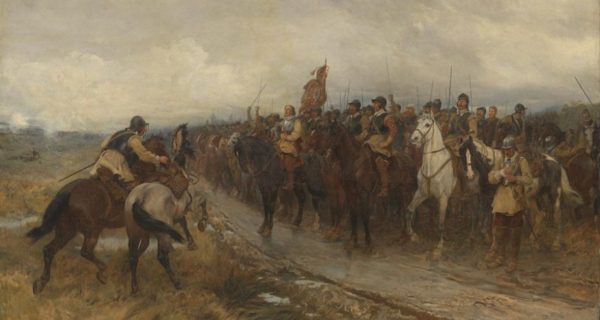Great antiques are not necessarily defined by great expense or rarity. Nor need they come from afar, or boast a provenance from some prestigious auction house or country manor. Rather, great antiques are simply the ones that rocket their beholder straight into the drama, poetry and beauty of the past. Therefore, it is hardly surprising that true connoisseurs of antiques are also connoisseurs of the past; they spend most of their time there, ascribing to the living and the dead a co-equal presence in the sweep of humanity. Intellectuality and emotionally, however, they are drawn to the dead.
High on my list of great antiques is a gold locket of miniature portrait size backed in lapis lazuli and containing a lock of John Hampden. One of the great opponents of King Charles I (remember the Ship Money Trial and the Long Parliament?), Hampden was Oliver Cromwell’s cousin and best regimental commander. He was killed in the English Civil War, fighting Prince Rupert at the Battle of Chalgrove Field in 1643.
There were two accounts of Hampden’s death. The more heroic, the one vastly preferred by generations of Whigs– Cromwell and Commonwealth sympathizers– had him honorably slain by an enemy musket ball to the right shoulder. The less heroic account, vastly preferred by the generations of Tories, who revered King Charles and despised Hampden, had it that Hampden was mortally wounded in battle when his own pistol, over-charged by a careless servant, ingloriously exploded in his hand!
When in 1828 it was decided to repair the crumbling floor of Great Hampden Church, the opportunity was seized to exhume the body and settle the controversy. Politicians, antiquaries and diggers were met at the church door by “Mr. Coventry” (see below). Tories lined up on one side of the entrance and Whigs on the other.
Newspapers and magazines broadcast all the graphic details: servants from nearby Hampden Hall gasping that the remarkably preserved face of the corpse matched exactly the Hampden portraits hanging on the staircase; the galloping and gruesome changes to that visage wrought by exposure to air; how the worm had been at work; Hampden’s auburn-brown hair tied up with a black ribbon; how the digging party, after propping Hampden up in the chancel, with his head resting on a shovel, had gone off to eat, abandoning him there for 24 hours in full view of a horrified visiting public, etc., etc!
Now, down to business. An examination revealed a possible right shoulder dislocation, but no bullet wound. Digging further through sawdust, foil and shroud, the searchers found the gloved right hand, mangled and totally detached. A few of its bones were contained in a little pouch tied to the waist. So, Hampden was felled by his own pistol! According to accounts, the Whigs present, who had prayed hard to find an honorable wound inflicted by the enemy, were plunged into despair. Some would insist to the end of their days that the wrong body had been dug and pointed to the absence of the customary nameplate on the coffin lid!
In addition to Hampden’s name and dates, the rim of the locket containing the lock of hair is elegantly engraved with this little quotation from Shakespeare’s “Julius Caesar,” from Marc Antony’s Funeral Oration: “Yea, beg a hair of him for memory.”
Finally, the locket is accompanied by a tattered, undated statement in the hand of John Hutchinson of the London Stock Exchange. Hutchinson declares that the lock was given to him by George Coventry (see above), who took it from the scalp of the “exhuminated” body of the “great patriot” John Hampden. Doubtlessly, Coventry was the eighth Earl of Coventry, who died in 1843. Hutchinson likely wrote his statement well before then — the sheet and its tiny envelope are stained with the curling shadow of the lock itself. The locket appears to date no later than the 1860’s or 70’s.
Riding this little rocket into the past, made as it is of gold, glass, lapis and hair, is nonetheless thrilling when one considers that, even before it became a great antique, its contents had lain over 180 years in the grave.
I’ve been asked to include a word about business dealings relating to Hampden’s hair. I bought it, in fact, on eBay, had it framed together with its associated note and envelope, and promptly sold the works to another dealer, an old friend, at the Gettysburg Civil War Show (you can ask the effervescent “Rosaria Marie” all about that event, which she knows well, and why she fancies 17th and 18th century cold steel!).
Now, I do try hard not to let antiques run away with my life, try hard to place matters of the Spirit well above the material– those are elementary propositions, child’s play for any Catholic homeschooler. Nevertheless, after selling the Hampden locket, I had trouble sleeping, would break into sweats in the dead of winter. In short, I was half the man I used to be. What else could I do but actually buy it back from my old dealer friend who, as you can imagine, showed no mercy, took advantage of my weakness and skinned me alive!


